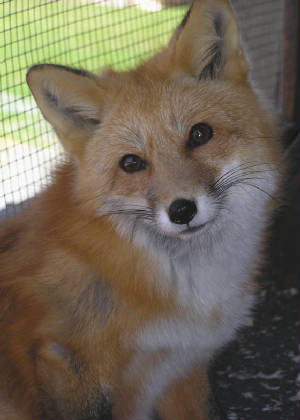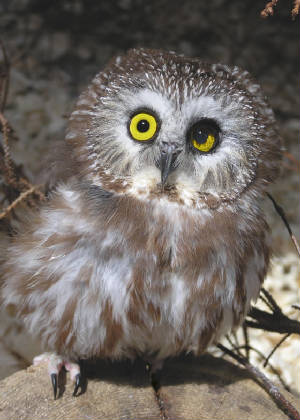|
|
 |
|
"In the end we will only conserve what we love. We will only love what we understand.
We will understand only what we are taught." - Baba Dioum
The Hope for Wildlife Society is committed to educating the community about the importance of Nova
Scotia's wildlife. The Society has an education center on site, which will be open to the public from 10-5, Monday-Saturday
in June, July, and August.
Education would not be possible without the help of our education animals. The animals involved
in education at the Hope for Wildlife Society are selected very carefully. The Society is often faced with the difficult
decision of whether to euthanize an animal, or involve them in the Society's education mission. Only
if the Society thinks that the animal will adapt to captivity in a way that allows them to have a meaningful quality
of life will they be considered for education purposes. All education animals are, for various reasons, unable
to be realeased into the wild.
Seeing wildlife firsthand provides children and adults a rare and memorable opportunity to
realize the importance of wildlife, as well as a chance to see the result of the hard work the Hope for Wildlife Society
does every day. Below are the stories of Toasty, Sweet Pea, Gretel, and SeaSaw. Click on the 'Information Sheet' buttons
for a link to a printable version of each story.
 |
 |
 GRETEL - A NEW BRUNSWICK PINE MARTIN
In April 2003, the Hope for Wildlife Society received a call from the Nova
Scotia Agricultural College in Truro; a mother pine marten had died and they wondered if the Society would raise two orphans.
Named
Hansel and Gretel, the pine marten kits weighed only 120g each and their eyes were still closed. Unfortunately, Hansel died
shortly afterward from a coccidia infection. Gretel, also infected, was saved by medication and around-the-clock care by the
Society’s volunteers.
Members of the weasel family, pine martens are an endangered species in Nova Scotia, with
less than 100 believed to be living in the upper Cape Breton Highlands. Because of Gretel’s New Brunswick lineage, the
Department of Natural Resources advised that she was not to be released back into the wild. As a result, Gretel has been raised
so that she is comfortable with human interaction.
Gretel now helps to educate visitors to the Hope for Wildlife Society’s
education center (especially young visitors) about endangered species in our own province by allowing them to actually meet
a member of this beautiful species up close.
|
|

|
|
 |
 |
|
 |
|
 |
 |
|

TOASTY – A NORTHERN FLYING SQUIRREL
In November 2007, a Bedford gentleman was preparing a fire in his wood stove when he heard
something in the chimney. He looked and could not see anything, so he finished lighting the fire. Shortly after, he looked
back at the roaring stove and was horrified at what he saw. There was a silhouette
of a little animal, paws outspread on the inside of the stove glass door. He
quickly opened the door, and a little fireball rolled out. He immediately put
out the flames on the unidentified burning animal. Unfortunately, it would be another day before he was put in touch with
the Hope for Wildlife Society. At that time, a Society volunteer transported the burned animal to the Dartmouth Veterinary Hospital
to be evaluated.
The animal was identified as a male northern flying squirrel. Veterinarian Barry MacEachern assessed the squirrel’s
injuries: All four paws, his ears, and his tail were badly burned. His whiskers
were scorched and his eyes were seared shut. The little patient would require antibiotic and pain medication, as well as twice
daily washing and application of an ointment on all his burned areas. Despite
this medical treatment, his future was still uncertain.
Under the care of the Hope for Wildlife Society volunteer, the squirrel, given the name ‘Toasty’,
began his slow healing process. From the beginning, Toasty’s will to live was strong and he tolerated the regular handling
involved in his daily care. After approximately a month, new skin began to appear on Toasty’s paws, and his fur began
to grow again. Unfortunately, he lost most of his outer ears, as well as the
end of his tail, and several toes. Toasty also underwent surgery to remove exposed bone in one rear foot.
Toasty still doesn’t have full use of his hind legs, so his climbing and gliding abilities are limited,
preventing his release back to the wild. He has grown accustomed to regular human interaction through
the care required for his rehabilitation. Toasty is involved in
educating visitors first hand about the important roll that these
little ‘flyers of the night’ play in our forest ecosystem.
|
|

|
|
 |
 |
|
 |
|
|
 |
|
|
 |
|
|
|
|
 |
 |
|

SWEET PEA - A THREE LEGGED FOX
In spring
of 2002, a young female fox was regularly observed at the Martinique Beach on Nova
Scotia’s Eastern Shore. Local residents, believing her to be orphaned,
began feeding the skinny young pup. Later that summer a call was placed to the Hope for Wildlife Society that the fox was
injured following an attack by a dog. A live trap succeeded in catching the fox and she was taken to the Hope for Wildlife
Society’s rehabilitation center.
Veterinarians
at the Dartmouth Veterinary
Hospital treated her for spinal cord injuries and she returned to the
wildlife center to rehabilitate. She was small and malnourished, and further
veterinary tests showed that she had rickets, caused by an inadequate amount of vitamin D. Her
rickets led her to break her hind leg the following spring. Unfortunately, it
was determined that the best course of action to take was to amputate her leg, leaving her with only 3 legs. Little Sweet Pea returned to the center to recover from the surgery.
Sweet Pea,
with only 3 legs, is not eligible for release back into the wild. Her friendly demeanour around people makes her a great candidate
for involvement in the Society’s education mission. She is also a foster
mom for injured and orphaned fox pups that are admitted into the center. Sweet Pea’s gentle temperament is endearing
to all that visit the Hope for Wildlife Society center.

|
|
 |
 |
 |
 |
|

SEA SAW – A NORTHERN SAW-WHET OWL
Sea Saw
is a Northern Saw-whet owl, the smallest owl species found in Nova Scotia. Sea Saw arrived at the Hope for Wildlife
Society rehabilitation center in 2006. He was found injured in the Annapolis
Valley with a badly injured left wing. It
is suspected that he was involved in a collision (possibly with a motor vehicle) on his left side, as he appears to be blind
on his left eye as well. A local veterinary hospital performed surgery on the small owl, amputating his irreparable wing.
Sea Saw’s
injuries left him with flying and visual limitations that prevent his release back into the wild. He has been successfully
growing accustomed to volunteers around the rehabilitation center and has begun to participate in educational programs at
the Hope for Wildlife Society. He gives visitors the opportunity to meet a beautiful bird up-close, and is involved in teaching
visitors about the important role these small owls play in our wildlife environment.

|
|
 |
 |



|
| BN#885062448RR0001 |
|
|
|
 |

